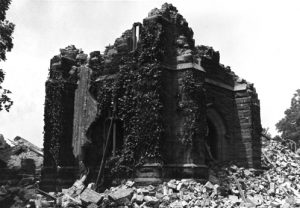“We Won’t Go!” – College of Wooster students reacting to the Vietnam War
The decade of the 1960s was a radical period in not only the nation’s but the College’s history. Throughout the United States, Americans staged protests related to the conflict in Vietnam and the Civil Rights movement. The College of Wooster was not left untouched by the changes occurring within American society. Wooster students demonstrated at the local draft board, chanting “We won’t go,” and filled the college newspaper, the Wooster Voice, with scathing criticisms of government, culture and society.1 One Wooster graduate, Norman Morrison class of 1956, would even go so far as self-immolation, burning himself alive outside of the gates of the Pentagon on November 2, 1965 in protest of U.S. involvement in Cambodia. The Institution of the College of Wooster itself did not escape criticism either. After two decades as head of the College, Lowry’s influence as president was wavering.2 Students constantly held protests over the mandatory daily chapel requirement, even as it was growing more and more secular. When one of their own was kicked out of school for being pregnant, students rebelled.3
 Just as many were questioning the societal structure of the United States, the College of Wooster, and the religious life of the College, the actual physical structure of Memorial Chapel was crumbling. The wooden supporting structure was rotting, and the ivy that decorated the exterior of the chapel4 had ruined the mortar of the stone façade.5 Facing foundation and structural problems, numerous roof leaks, and falling plaster, the College was forced into action.6
Just as many were questioning the societal structure of the United States, the College of Wooster, and the religious life of the College, the actual physical structure of Memorial Chapel was crumbling. The wooden supporting structure was rotting, and the ivy that decorated the exterior of the chapel4 had ruined the mortar of the stone façade.5 Facing foundation and structural problems, numerous roof leaks, and falling plaster, the College was forced into action.6
As the project began, former Wooster graduates, many of them established religious leaders, felt it was their duty to weigh in on the undertaking. Most of these unsolicited responses criticized the decision to raze the chapel and argued for constructing a new building at a new site.7 The old chapel was a beloved symbol of Wooster, and many alumni held deep connections to it. It was the site of many memories, and because of the small building’s intimate feel, was often said to hold the spirituality of Wooster.8
The first architectural firm hired to design the new chapel was fired from the project twice.9 In reviewing the firm’s work, members of the chapel committee felt that the design was, “not based on any philosophy of what the College stands for, and thus lacks significance.” Furthermore, the committee felt that the proposed building, “was too much tied to the past rather than to an imaginative future.”10 The committee wanted a building that was a mix of the old and new, of the secular and the sacred. They wanted a chapel and a meeting hall. They wanted a transformative space that blended traditional Christian forms and images with those of a more secular and relevant ideology.
On March 1, 1968, a new architect was hired. Victor Christ-Janer, a modernist architect and professor of architecture at Columbia, designed a chapel unlike anything the College had ever seen.
photograph courtesy of COWSC
- For a more complete account of the 1960s at The College of Wooster, see: Levy, “McGaw Chapel,” 22-53. ↩
- Arn Lewis, “Letter to President R. Stanton Hales,” August 7, 2002, obtained from the author. ↩
- Levy, “McGaw Chapel,” 31. See also, “The Unpardonable Sin,” The Wooster Voice, October 29, 1965. ↩
- The ivy was an unmistakable nod the typical European university, just another example of The College borrowing elements and traditions to impart legitimacy. ↩
- A. F. Blaser, “Letter to Dr. Howard Lowry,” May 5, 1947, Memorial Chapel Correspondence, B&G, COWSC. ↩
- “Program for Preliminary Design Studies of the Chapel of The College of Wooster,” January 23, 1964, McGraw Chapel Correspondence, B&G, COWSC. ↩
- To read these letters, consult the McGraw Chapel Correspondence, B&G, COWSC. ↩
- Wooster Daily Record. “Chapel Memories Will Live On After Building Is Gone,” June 7 ,1969. ↩
- “Letter to Schafer, Flynn & Van Dijk Associates,” January 11, 1967 and Letter to Schafer, Flynn & Van Dijk Associates,” October 20, 1967 both part of the McGaw Chapel Correspondence, B&G, COWSC. ↩
- “Letter to the Architect and Members of the Committee on the Proposed Chapel,” November 29, 1964, McGraw Chapel Correspondence, B&G, COWSC. ↩